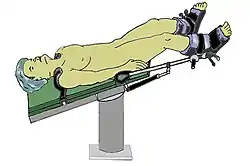Lloyd-Davies position is a medical term referring to a common position for surgical procedures involving the pelvis and lower abdomen. The majority of colorectal and pelvic surgery is conducted with the patient in the Lloyd-Davies position. It was popularised for these procedures by Oswald Lloyd-Davies working at St Marks Hospital London.[1]

Lloyd-Davies Position
It is derived from the Trendelenburg position but with the legs abducted to allow access to the perineum. The basic angle is a 30-degree Trendelenburg with the hips flexed at 15 degrees; this can be adjusted with leg supports.
Advantages
- The position gives good exposure and may minimize pressure area damage in longer surgeries.
- It has fewer neuropathological side effects compared with other positions, notably lithotomy position where the hips are almost fully flexed.
Disadvantages
- Uncommonly it can precipitate compartment syndrome in muscles of calves after 5 or more hours of surgery.[2]
See also
References
This article is issued from Wikipedia. The text is licensed under Creative Commons - Attribution - Sharealike. Additional terms may apply for the media files.